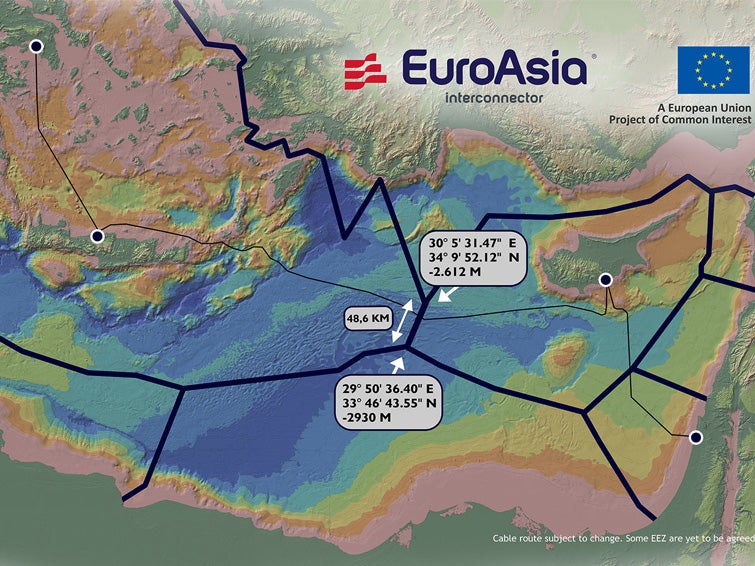EuroAsia Interconnector is a 400kV high-voltage direct current (HVDC) subsea cable system planned to connect the electricity grids of Israel, Cyprus, and Greece (Crete and Attica) with the European transmission network.
Traversing a total length of 1,518km, it will be the world’s longest interconnector cable linking Europe and Asia.
The European Union (EU) has recognised EuroAsia Interconnector as a project of common interest (PCI) and appointed EuroAsia Interconnector Limited as the promoter of the project.
The participants in the project include the Public Power Corporation (PPC) of Greece, Israel Electric Corporation, Quantum Corporation Group, and DEH Quantum Energy.
Estimated to cost €3.5bn ($3.9bn), the first stage development of the interconnection project will have a transmission capacity of 1GW, which is planned to be increased to 2GW in the next stage.
The interconnector is expected to commence partial operations in 2022, while the full-scale operations of the phase one are expected to begin by the end of 2023.
EuroAsia Interconnector route and design details
The EuroAsia Interconnector line will originate at Hadera in Israel and run for 310km across sea to connect Kofinou in Cyprus. From there, it will run westwards and again take a subsea route to connect Korakia point in Crete, the largest island of Greece. The length of the Cyprus-Crete segment will be 879km.
From Crete, the interconnector will further run for 329km to connect Attica, in the mainland of Greece.
The lowest laying point for the cable will be 3,000m below sea-level in the Mediterranean basin, which will make it the world’s deepest under-sea cable.
The project will involve the construction of four voltage source converters (VSC) type HVDC convertor stations, one each in Israel, Cyprus, Crete, and Attica. Each converter station will have an associated sea-electrode.
The converter stations will convert electricity from DC to alternating current (AC) for feeding into their respective transmission grids.
The transmission capacity of the EuroAsia Interconnector system is planned to be increased to 2GW by installing two more converter stations in Attica and Israel, at a later stage.
Project timeline
The interconnection between Crete and Attica is expected to be operational by June 2022, while the Cyprus-Crete and the Cyprus-Israel interconnections are scheduled for commissioning by the end of 2023.
EuroAsia Interconnector project development details
The feasibility studies for the EuroAsia Interconnector project were initiated in 2012, while survey works on the sea-bed were initiated in January 2016.
Environmental approval from the Cyprus Government was secured in 2017, while three state leaders of Cyprus, Israel, and Greece extended support for the timely implementation of the project, in a trilateral summit held in April 2019.
The tender documents for the stage one construction of the project were issued in January 2019, while the Cyprus Government approved a 33-year land concession agreement for a HVDC converter station for the project in June 2019.
EuroAsia Interconnector significance
With a bi-directional transmission facility, the cross-border interconnector will serve as a reliable energy bridge between Europe and Asia. Running across the Mediterranean Sea, the power cable will also bring an end to the energy isolation of Cyprus, the EU’s only member state with no electricity or gas interconnection.
The project will also play a strategic role in allowing the use of gas reserves held by Cyprus and Israel, along with renewable energy sources, to fulfil Europe’s internal energy requirement.
Financing
EuroAsia Interconnector received 50% funding for the pre-works studies from the EU’s Connecting Europe Facility (CEF), in the form of grants.
The project is also eligible to receive grants worth half of the construction cost from CEF, along with additional financing facilities from the European Investment Bank and other EU institutions.
Contractors involved
The environmental impact assessment (EIA) report for the stage one of the EuroAsia Interconnector project was prepared by Atlantis Consulting Cyprus in November 2016.
G.A.S., a research company based in Italy, was engaged for the route survey for the cable project in January 2016.






